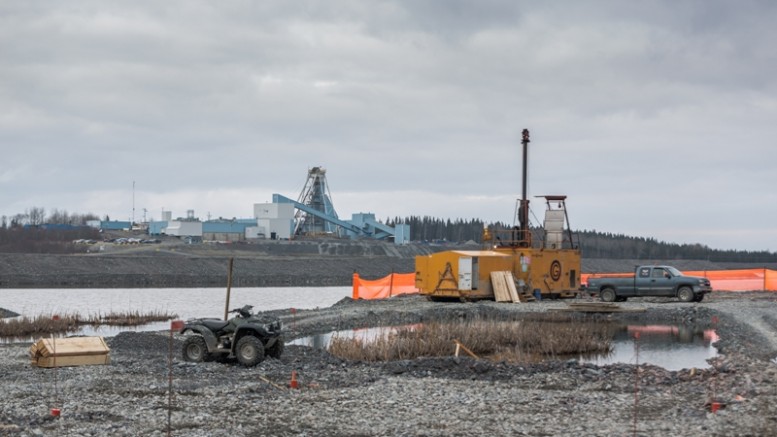VANCOUVER — Metanor Resources (TSXV: MTO) is stepping up work at its new Moroy gold discovery 1 km south of its producing Bachelor Lake gold mine in Quebec’s Val-d’Or district with a 60,000-metre drill program.
Ronald S. Perry, vice-president and treasurer of Metanor, tells The Northern Miner during a phone interview that the company intends to “build minable ounces” to develop a second source of feed for Bachelor Lake, which has been hit with lower head grades in the past two quarters.
“They always say you can find another mine either under the tailings dam or in the shadow of a headframe,” he says. “And when you’re standing at Moroy looking at Bachelor Lake’s majestic mill, it’s easy to say we’re lucky.”
Metanor first sniffed gold in four holes drilled beneath the mine’s tailings dam in 2013, but knew it was onto something when drilling in 2015 returned 10.1 grams gold per tonne over 26.2 metres (not true thickness) from surface.
The mineralized structure has been noted in widely spaced holes across a 570-metre strike and to 500 metres depth, with cuts of 6.4 metres of 9.2 grams gold at 85% true thickness, according to the company’s most recent results.

“The beauty of Moroy is that the mill is already there, so the internal rate of return for the project would be instant. you don’t need to be a Harvard MBA to know that”
Ronald S. Perry
Vice-president and treasurer, Metanor Resources
Perry says the shallow high-grade hits correspond with one of four vertical induced-polarization (IP) geophysical anomalies delineated by down-hole surveys alongside last year’s drilling.
The other IP targets have yet to be tested, Perry adds, noting that the top of the strongest anomaly is 200 metres deep, and falls in line with the projected dip and strike of the gold structure outlined at surface, estimated as dipping 65 degrees north.
“We’re chasing these anomalies, and we’re excited enough to know it’s worth 60,000 metres,” he says. “We have $3 million in flow-through we have to spend, so we decided we’re going to put it all in Moroy because it’s worth it. So what we’ll end up with is exploration, plus resource definition.”
Mineralization at Moroy falls within the same category as the nearby Bachelor Lake deposit — an Archean-aged, disseminated gold system within sheared basalts — which saw historical underground production of 130,341 oz. gold at 5 grams gold between 1982 and 1989.
Between 2005 and 2010, Metanor stepped in and refurbished the mine with a carbon-in-pulp processing plant, and raised the capacity of the mill to 800 to 1,200 tonnes per day, depending on rock hardness.
Measured and indicated resources were updated in 2011 to 842,000 tonnes of 7.79 grams gold for 211,000 oz. gold and inferred resources of 426,000 tonnes of 6.52 grams gold for 89,400 oz. gold, with commercial production achieved in 2013.
Perry says that despite the weaker Canadian dollar, the past couple of quarters have been “tough” for Metanor. He blames falling head grades as mining advances into a narrow, mineralized structure called the “A” vein.
The company recovered 15,800 oz. gold from 111,000 tonnes grading of 4.6 grams gold in the six months ending Dec. 31, compared to 19,900 oz. recovered from 116,000 tonnes at 5.5 grams gold for the comparable period in 2015.
Production cash costs for Metanor’s second quarter in 2016 (i.e., the three months ended Dec. 31, 2015) were C$1,346 per oz. gold, whereas sustaining costs came in at C$1,574 per oz. gold.
“We’re now starting to mine on the Hewfran section, which is 6 to 8 grams gold on average, so in time production will go back up … and as we go through these higher-grade zones, we predict we’ll be cash-flow positive through the rest of the year.”
The company posted a $3.8-million net loss in the second quarter of 2016, but Perry points out that $2.6 million is considered depreciation, and the rest of the loss came from exploration ramping up at Moroy.
“The beauty of Moroy is that the mill is already there, so the internal rate of return for the project would be instant — you don’t need to be a Harvard MBA to know that,” he says. “We know that for a small investment of $1.5 million we can increase the mill capacity by 50%, and that’s why we’re excited and looking towards the future.”
The junior producer has also drawn the interest of financier Eric Sprott, who on March 11 increased his stake in the company to 7.1% by acquiring another 7 million shares. Sprott also holds 50 million warrants, and if exercised, his stake in the company would be 11.3%.
“The future bodes well and we’re attracting new shareholders. We’ve got a big drill program and we’re getting out there telling the story,” he says.
Metanor also holds the open-pit Barry gold mine, 117 km from Bachelor Lake, which saw production of 617,000 tonnes at 2.21 grams gold for 44,000 oz. gold between 2008 and 2010.
A resource update at Barry in 2010 tallied 7.7 million indicated tonnes at 1.25 grams gold for 309,500 oz. gold, and 10.4 million inferred tonnes at 1.41 grams gold for 472,000 oz. gold, but Metanor shelved the low-grade open-pit operation until market conditions improve.
“We’re planning a drill program at Barry to see if we can high-grade the pit and get it back in production, and crank up the numbers in 2017,” Perry says.
“At Barry, we’re surrounded by Oban Mining and Beaufield Resources — so we’re right in the middle of a hot new mining camp. We’re getting free publicity from everyone and our share price is moving in the right direction.”
Metanor shares have traded within a 52-week range of 3¢ to 12¢, and closed at 8¢ at press time. The company has 421.2 million shares outstanding for a $34-million market capitalization.


Be the first to comment on "Metanor takes aim at Moroy in Quebec"